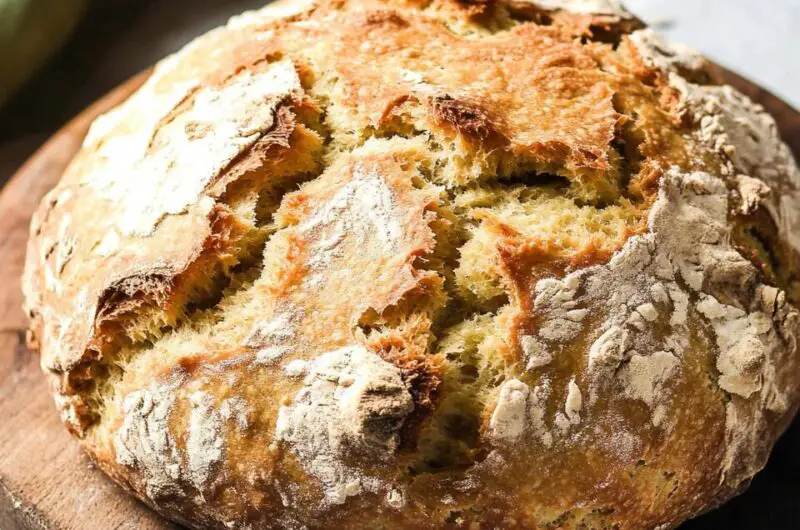Irish Soda Bread is a true taste of tradition warm, golden, and full of rustic charm. This no-yeast bread relies on buttermilk and baking soda for its rise, creating a dense yet soft interior with a crisp, golden crust. Whether served with a smear of butter, drizzled with honey, or paired with a hearty Irish stew, this bread is a staple for any occasion. The beauty of this recipe lies in its simplicity. With just a handful of pantry staples, you can whip up a homemade loaf that fills your kitchen with the nostalgic aroma of fresh bread. Whether you’re baking for St. Patrick’s Day or simply craving a comforting homemade treat, this Irish Soda Bread is a must-try.
Full Recipe:
Ingredients:
- 1 and 3/4 cups (420ml) buttermilk
- 1 large egg (optional)
- 4 and 1/4 cups (531g) all-purpose flour (spooned & leveled), plus more for dusting
- 3 tablespoons (38g) granulated sugar
- 1 teaspoon baking soda
- 1 teaspoon salt
- 5 tablespoons (71g) unsalted butter, cold and cubed
- 1 cup (150g) raisins (optional)
Directions:
- Preheat oven to 400°F (204°C). Line a baking sheet with parchment paper or grease a cast iron skillet, cake pan, or pie dish.
- In a bowl, whisk together the buttermilk and egg.
- In a separate large bowl, whisk together the flour, sugar, baking soda, and salt.
- Cut the cold butter into the flour mixture using a pastry cutter or your fingers until the mixture resembles coarse crumbs.
- Stir in the raisins if using.
- Pour in the buttermilk mixture and gently fold everything together until it forms a shaggy dough.
- Turn the dough onto a lightly floured surface and knead for about 30 seconds until it comes together.
- Shape the dough into a round loaf and transfer to the prepared baking pan.
- Use a sharp knife to score a deep “X” on top of the dough.
- Bake for 45-55 minutes, until the bread is golden brown and a toothpick inserted in the center comes out clean. If browning too quickly, tent with foil.
- Let cool for 10 minutes, then transfer to a wire rack. Serve warm with butter or jam.
Prep Time: 10 minutes | Cooking Time: 50 minutes | Total Time: 1 hour
Kcal: 245 kcal per slice | Servings: 8 servings
The History and Cultural Significance
The origins of Irish Soda Bread trace back to Ireland’s rural communities, where access to yeast and expensive ingredients was limited. Farmers and homemakers needed a reliable, simple method for making bread, and the introduction of baking soda (sodium bicarbonate) provided the perfect solution. By combining soda with the naturally occurring acids in buttermilk, bakers were able to create a light, airy texture without the need for fermentation.
During the 19th century, the potato famine devastated Ireland, making staple foods scarce. Soda bread became even more important as an affordable and filling source of sustenance. It required only four basic ingredients flour, baking soda, salt, and buttermilk all of which were commonly found in Irish households. The simplicity of the recipe made it accessible to families of all income levels, ensuring that no one went hungry.
Traditionally, Irish Soda Bread was baked in a cast-iron pot or a bastible (a type of heavy-lidded pot), placed directly over an open fire or in a hearth oven. The method of scoring the top of the dough with a deep “X” was not just for aesthetic purposes it was believed to ward off evil spirits and bring blessings to the household.
Today, soda bread remains a beloved staple in Irish homes and is especially popular around St. Patrick’s Day, when people celebrate Irish heritage with traditional foods.
What Makes Irish Soda Bread Unique?
One of the standout qualities of Irish Soda Bread is its signature texture and flavor. Unlike yeast bread, which tends to be soft and fluffy, soda bread has a denser crumb with a crisp, slightly chewy crust. The reaction between baking soda and buttermilk gives the bread a distinct tangy flavor that pairs beautifully with both sweet and savory toppings.
Another unique aspect of this bread is how adaptable it is. While the classic version sticks to basic pantry staples, many variations exist, allowing bakers to customize it to their liking. Some popular adaptations include:
- Sweet Irish Soda Bread – Includes sugar, raisins, currants, or orange zest for a slightly sweeter taste.
- Brown Soda Bread – Made with whole wheat flour for a nuttier, heartier flavor.
- Seeded Soda Bread – Features caraway seeds, flaxseeds, or sunflower seeds for added texture.
- Cheesy Soda Bread – Incorporates sharp cheddar or Irish cheese for a rich, savory twist.
No matter the variation, Irish Soda Bread remains one of the easiest and most rewarding homemade breads to make.
Tips for the Best Irish Soda Bread
If you want to bake the perfect loaf of Irish Soda Bread, here are a few key tips to keep in mind:
- Use Cold Butter – Similar to making scones or biscuits, cutting cold butter into the flour helps create a tender crumb and prevents the bread from becoming too dense.
- Don’t Overmix the Dough – Soda bread dough should be mixed just until it comes together. Overworking it will result in a tougher texture.
- Score the Top – Making a deep “X” on top of the dough allows heat to reach the center, ensuring even baking.
- Use Buttermilk for Authentic Flavor – The acidity in buttermilk is essential for activating the baking soda. If you don’t have buttermilk, you can make a substitute by mixing regular milk with a tablespoon of vinegar or lemon juice.
- Bake in a Cast-Iron Skillet – While you can use a baking sheet or a cake pan, a cast-iron skillet gives the bread a beautifully crisp crust.
How to Serve and Store Irish Soda Bread
Irish Soda Bread is incredibly versatile and can be enjoyed in a variety of ways. The most traditional way to serve it is warm with a pat of butter or a drizzle of honey. It also pairs beautifully with jams, marmalades, and even savory spreads like cheese and smoked salmon.
For a heartier meal, Irish Soda Bread is the perfect accompaniment to soups and stews. Its slightly dense texture makes it ideal for soaking up broths and gravies, making it a must-have alongside Irish dishes like Guinness beef stew or potato leek soup.
To store leftover soda bread, wrap it in aluminum foil or place it in an airtight container. It will stay fresh at room temperature for up to two days. For longer storage, keep it in the refrigerator for up to a week or freeze it for up to three months. To reheat, simply warm slices in a toaster or oven.
Conclusion:
Irish Soda Bread is a testament to the beauty of simple, rustic baking. With minimal ingredients and no need for yeast, it’s an easy and rewarding bread that has stood the test of time. Whether you’re making it for a special occasion like St. Patrick’s Day or as an everyday staple, this bread brings warmth, comfort, and a taste of Irish tradition to your table.
By baking a loaf of Irish Soda Bread, you’re not just making a delicious treat you’re connecting with a rich culinary heritage that has nourished generations. So preheat your oven, grab your ingredients, and enjoy the simple pleasure of homemade soda bread!








